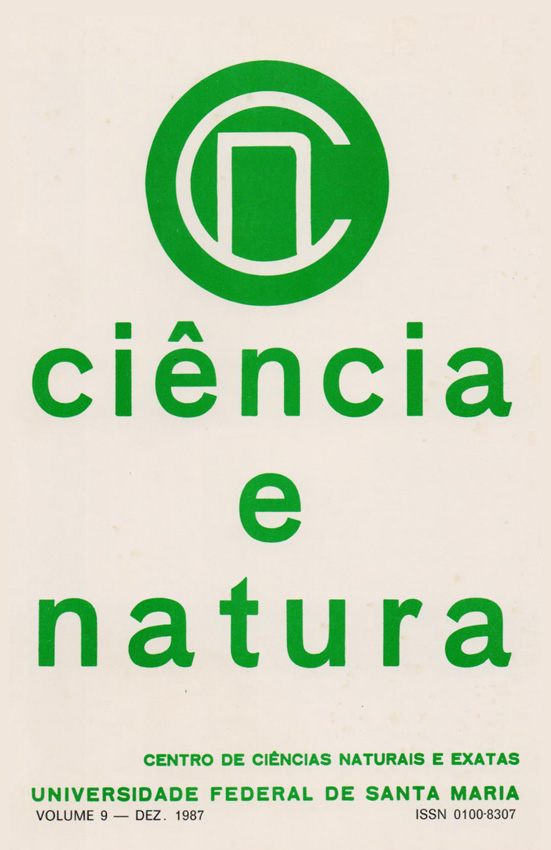Um modelo computacional para reforço de conteúdo programático no estudo de intervalos
DOI:
https://doi.org/10.5902/2179460X25454Resumo
Este trabalho visa apresentar um modelo matemático através de um programa computacional que permita ao aluno da primeira série do II grau reforçar o conteúdo programático de operação entre dois intervalos reais finitos. As operações desenvolvidas são a união e interseção entre os dois conjuntos. Foi utlizado no desenvolvimento do programa um microcomputador da linha APPLE, 64 Kb, 8 bits, linguagem BASIC.
Downloads
Referências
FERNANDEZ, V.P. & YOUSSEF, A.N. Matemática para o colégio, curso completo, São Paulo, Editora Scipione Ltda, 1987. 344 p.
DE DOMÊNICO, L.C. Matemática Segundo Grau, Volume 1, São Paulo, Instituto Brasileiro de Edições Pedagógicas, 164 p.
FERNANDEZ, V.P. & YOUSSEF, A.N. O computador na escola, São Paulo, Editora Scipione Ltda, 1986, 128 p.
SCHIMIZU, T. BASIC,. São Paulo, Editora Atlas S.A. 1986, 213 p.
BORATTO, F. BASIC para Engenheiros e Cientistas, Rio de Janeiro, Livros Tecnicos e Cientlficos Editora S.A., 1985,120 p.
MAGRI, J. Programação BASIC. São. Paulo, Editora Atlas, 1984, 218p.
MIRSHAWKA, V. BASIC sem segredos, Editora Nobel S.A., São Paulo, 1985, 4e edição, 370 p.
FERNANDEZ, J. N. & ASHLEY, R. Usando CP/M, Editora Campos Ltda, Rio de Janeiro, 1984, 236 p.
WILCOX, C.M. APPLE II Jogos, Editora Mc Graw-Hill Ltda, São Paulo, 1986, 178 p.
POOLE, L. & BORCHERS, M. & CASTLEWITZ, D. Programas usuais em BASIC para sistemas compatíveis com o APPLE II, Editora Mc Graw-Hill Ltda, 1984, 187 p.
Downloads
Publicado
Como Citar
Edição
Seção
Licença
Para acessar a DECLARAÇÃO DE ORIGINALIDADE E EXCLUSIVIDADE E CESSÃO DE DIREITOS AUTORAIS clique aqui.
Diretrizes Éticas para Publicação de Revistas
A revista Ciência e Natura está empenhada em garantir a ética na publicação e na qualidade dos artigos.
A conformidade com padrões de comportamento ético é, portanto, esperada de todas as partes envolvidas: Autores, Editores e Revisores.
Em particular,
Autores: Os Autores devem apresentar uma discussão objetiva sobre a importância do trabalho de pesquisa, bem como detalhes e referências suficientes para permitir que outros reproduzam as experiências. Declarações fraudulentas ou intencionalmente incorretas constituem comportamento antiético e são inaceitáveis. Artigos de Revisão também devem ser objetivos, abrangentes e relatos precisos do estado da arte. Os Autores devem assegurar que seu trabalho é uma obra totalmente original, e se o trabalho e / ou palavras de outros têm sido utilizadas, isso tem sido devidamente reconhecido. O plágio em todas as suas formas constitui um comportamento publicitário não ético e é inaceitável. Submeter o mesmo manuscrito a mais de um jornal simultaneamente constitui um comportamento publicitário não ético e é inaceitável. Os Autores não devem submeter artigos que descrevam essencialmente a mesma pesquisa a mais de uma revista. O Autor correspondente deve garantir que haja um consenso total de todos os Co-autores na aprovação da versão final do artigo e sua submissão para publicação.
Editores: Os Editores devem avaliar manuscritos exclusivamente com base no seu mérito acadêmico. Um Editor não deve usar informações não publicadas na própria pesquisa do Editor sem o consentimento expresso por escrito do Autor. Os Editores devem tomar medidas de resposta razoável quando tiverem sido apresentadas queixas éticas relativas a um manuscrito submetido ou publicado.
Revisores: Todos os manuscritos recebidos para revisão devem ser tratados como documentos confidenciais. As informações ou ideias privilegiadas obtidas através da análise por pares devem ser mantidas confidenciais e não utilizadas para vantagens pessoais. As revisões devem ser conduzidas objetivamente e as observações devem ser formuladas claramente com argumentos de apoio, de modo que os Autores possam usá-los para melhorar o artigo. Qualquer Revisor selecionado que se sinta desqualificado para rever a pesquisa relatada em um manuscrito ou sabe que sua rápida revisão será impossível deve notificar o Editor e desculpar-se do processo de revisão. Os Revisores não devem considerar manuscritos nos quais tenham conflitos de interesse resultantes de relacionamentos ou conexões competitivas, colaborativas ou outras conexões com qualquer dos autores, empresas ou instituições conectadas aos documentos.






